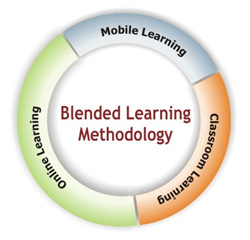
This summer, I have sought to understand blended learning better, what that looks like in the classroom, and how instructors can engage students in authentic and meaningful learning. While this is a less traditional model of learning, schools are shifting toward blended learning environments and options for students to participate in self-directed education. I admit that I have reservations; I am worried that students are not mature enough to handle a blended environment or may view a blended class as an out of sight (or out of the classroom) out of mind situation. Will students view this type of learning as an opportunity to further their knowledge and skills, or will they view this learning format as a means of checking off tasks to finish a course as quickly as possible? On the instructional end, I am curious as to how to effectively design a course to avoid these concerns and encourage students to process and grow from the material presented to them. My worries do not seem unique from other teachers, and as such, I have been working to grasp the possibilities that this flexible way of designing a course can provide.
At ISTE, I had the opportunity to speak with a few educators who have already implemented blended learning in their schools, and they echoed the same concerns as well as an excitement for what this type of learning could provide for our students. They explained that some students appeared to work quickly to complete work and earn the right to leave the classroom or not attend class on a given day. On the days students were not in class, when surveyed, students often admitted to not thinking about the course and perhaps not using their flex time to pursue other academic studies. This scenario defeats the purpose and can send the wrong message about blended learning. Another concern that I heard echoed at ISTE involved the school facilities. Implementing this style of learning in a traditional school setting that might not have the correct facilities and resources available, could prove to be problematic.
At the same time, blended learning provides students with more time to demonstrate learning in their own unique ways, allows teachers to group students based on abilities, and provide more one-on-one and small group instruction. These experiences benefit students and allow learning to be more personalized and differentiated. To help implement blended learning effectively, these teachers expressed that students need to be trained and taught how to learn in this environment, as they do every fall when they enter a new class. As teachers, we will need to show them how to learn in this environment, why this style of learning is beneficial, and strive to keep them engaged, motivated, and stretched cognitively.
At the same time, blended learning provides students with more time to demonstrate learning in their own unique ways, allows teachers to group students based on abilities, and provide more one-on-one and small group instruction. These experiences benefit students and allow learning to be more personalized and differentiated. To help implement blended learning effectively, these teachers expressed that students need to be trained and taught how to learn in this environment, as they do every fall when they enter a new class. As teachers, we will need to show them how to learn in this environment, why this style of learning is beneficial, and strive to keep them engaged, motivated, and stretched cognitively.
Our goal as educators is to create critical thinkers - people who are ready to be active and productive members of society. We also strive to create curious, life-long learners who are excited to pursue the subjects about which they are passionate. Blended learning could provide students with more of a sense of autonomy and revive that excitement about learning that can get lost in a classroom. They could feel empowered and in control of their learning, which leads to an increase in intrinsic motivation. In addition, this style of learning will make them more independent as we move away from traditional memorization of the past and focus on analyzing, synthesizing, and applying information accessed on a variety of print and online sources.
With anything new, there is a fear that it will fail. Of course, there will be bumps in the road. With an evolving higher education system, one that offers an array of online learning and blended learning experiences, it makes sense that the high school setting would seek to prepare students for this type of learning and seek to discover the benefits that a blended environment could have on educating today's students. I am excited to experiment with a few simulated blended learning lessons and experiences this year as I take on Canvas, an LMS that my district has asked me to test and work with a colleague who is tackling her first official blended psychology course. Also, I am excited to challenge students to continue to demonstrate their knowledge in a variety of ways, engage in both face-to-face and online discussions, and continue to develop their 21st-century literacy skills. Also, I am eager to reexamine how I teach my students and rethink my learning environment to best meet the present and future needs of the students sitting in my classroom this fall.
Every year brings new challenges. Learners continue to change as quickly as the technology in our hands. With that, comes a new learning process for me as a teacher and life-long learner, too. While changing the modality of learning and rethinking the classroom environment can be slightly unnerving, as Henry Ford points out in his quote, sometimes we are simply unaware of how a different mode of [transportation] can be transformative and empowering. Like the car was for the early 20th century, changing up the learning environment could have lasting and positive impacts on our students and our future. Bring on this new challenge, and let's find new ways to permit students to be the true drivers of their learning.
































